

Compact Muon Solenoid
LHC, CERN
| CMS-SMP-17-005 ; CERN-EP-2018-161 | ||
| Measurement of differential cross sections for Z boson pair production in association with jets at $\sqrt{s}= $ 8 and 13 TeV | ||
| CMS Collaboration | ||
| 28 June 2018 | ||
| Phys. Lett. B 789 (2019) 19 | ||
| Abstract: This Letter reports measurements of differential cross sections for the production of two Z bosons in association with jets in proton-proton collisions at $\sqrt{s} = $ 8 and 13 TeV. The analysis is based on data samples collected at the LHC with the CMS detector, corresponding to integrated luminosities of 19.7 and 35.9 fb$^{-1}$ at 8 and 13 TeV, respectively. The measurements are performed in the leptonic decay modes $\mathrm{Z}\mathrm{Z}\to\ell^+ \ell^- \ell'^+ \ell'^-$, where $\ell,\ell' = \mathrm{e}$, $\mu$. The differential cross sections as a function of the jet multiplicity, the transverse momentum ${p_{\mathrm{T}}}$, and pseudorapidity of the ${p_{\mathrm{T}}}$-leading and subleading jets are presented. In addition, the differential cross sections as a function of variables sensitive to the vector boson scattering, such as the invariant mass of the two ${p_{\mathrm{T}}}$-leading jets and their pseudorapidity separation, are reported. The results are compared to theoretical predictions and found in good agreement within the theoretical and experimental uncertainties. | ||
| Links: e-print arXiv:1806.11073 [hep-ex] (PDF) ; CDS record ; inSPIRE record ; HepData record ; CADI line (restricted) ; | ||
| Figures | |

png pdf |
Figure 1:
Distribution of the reconstructed jet multiplicity in the 8 TeV (left) and 13 TeV (right) data. The points represent the data and the vertical bars correspond to the statistical uncertainty. The shaded histograms represent MC predictions and the background estimates, while the hatched band on their sum indicates the systematic uncertainty of the prediction. The Z+jets and ${{\mathrm {t}\overline {\mathrm {t}}}}$ background is obtained from the data. |
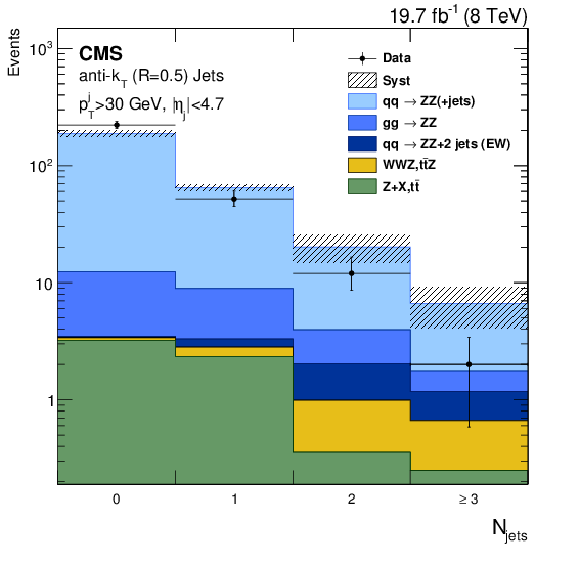
png pdf |
Figure 1-a:
Distribution of the reconstructed jet multiplicity in the 8 TeV data. The points represent the data and the vertical bars correspond to the statistical uncertainty. The shaded histograms represent MC predictions and the background estimates, while the hatched band on their sum indicates the systematic uncertainty of the prediction. The Z+jets and ${{\mathrm {t}\overline {\mathrm {t}}}}$ background is obtained from the data. |
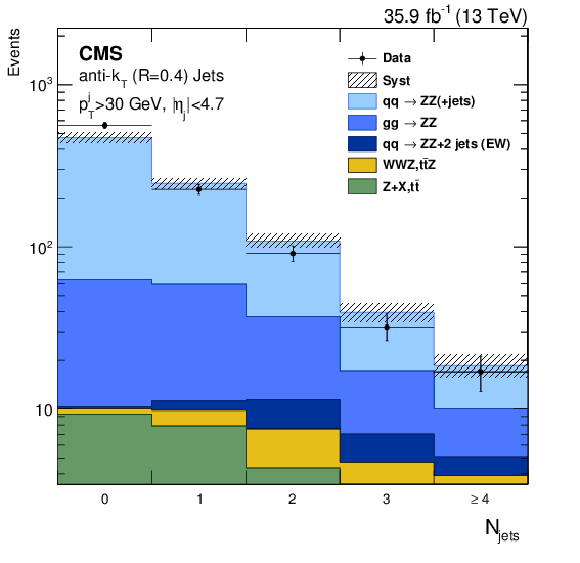
png pdf |
Figure 1-b:
Distribution of the reconstructed jet multiplicity in the 13 TeV data. The points represent the data and the vertical bars correspond to the statistical uncertainty. The shaded histograms represent MC predictions and the background estimates, while the hatched band on their sum indicates the systematic uncertainty of the prediction. The Z+jets and ${{\mathrm {t}\overline {\mathrm {t}}}}$ background is obtained from the data. |
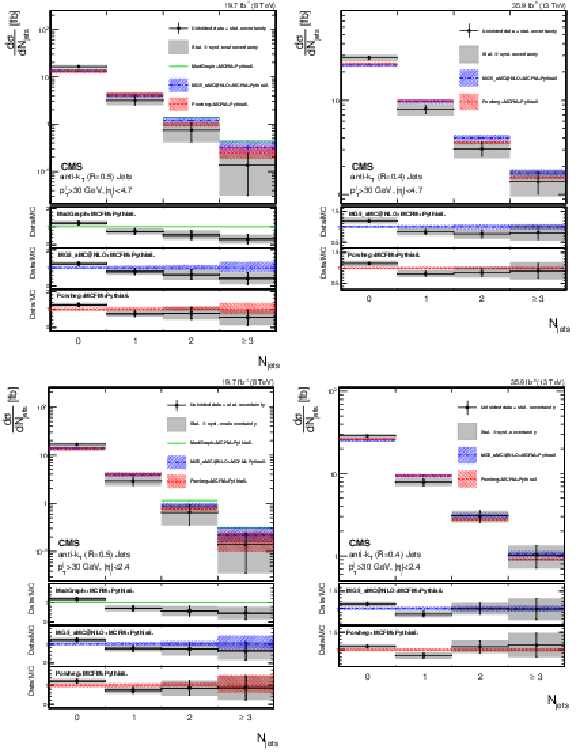
png pdf |
Figure 2:
Differential cross sections of $ {\mathrm {p}} {\mathrm {p}}\to {\mathrm {Z}} {\mathrm {Z}} \to 4\ell $ as a function of the multiplicity of jets with $ | \eta _{\mathrm {j}} | < $ 4.7 (top panels) and $ | \eta _{\mathrm {j}} | < $ 2.4 (bottom panels), for the 8 (left) and 13 (right) TeV data. The measurements are compared to the predictions of MG5_aMC@nlo, POWHEG, and MadGraph5 (8 TeV only) sets of samples. Each MC set, along with the main MC generator, includes the MCFM and Phantom generators. PYTHIA 6 and PYTHIA 8 are used for parton showering, hadronization, and underlying event simulation, for the 8 and 13 TeV analysis, respectively, with the sole exception of MG5_aMC@nlo, which is always interfaced to PYTHIA 8. The total experimental uncertainties are shown as hatched regions, while the colored bands display the theoretical uncertainties in the matrix element calculations. |
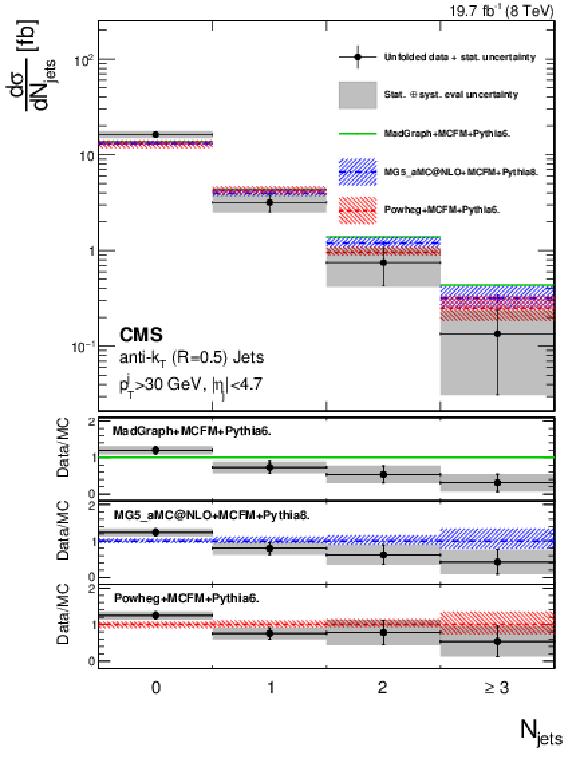
png pdf |
Figure 2-a:
Differential cross sections of $ {\mathrm {p}} {\mathrm {p}}\to {\mathrm {Z}} {\mathrm {Z}} \to 4\ell $ as a function of the multiplicity of jets with $ | \eta _{\mathrm {j}} | < $ 4.7, for the 8 TeV data. The measurements are compared to the predictions of MG5_aMC@nlo, POWHEG, and MadGraph5 (8 TeV only) sets of samples. Each MC set, along with the main MC generator, includes the MCFM and Phantom generators. PYTHIA 6 and PYTHIA 8 are used for parton showering, hadronization, and underlying event simulation, for the 8 and 13 TeV analysis, respectively, with the sole exception of MG5_aMC@nlo, which is always interfaced to PYTHIA 8. The total experimental uncertainties are shown as hatched regions, while the colored bands display the theoretical uncertainties in the matrix element calculations. |
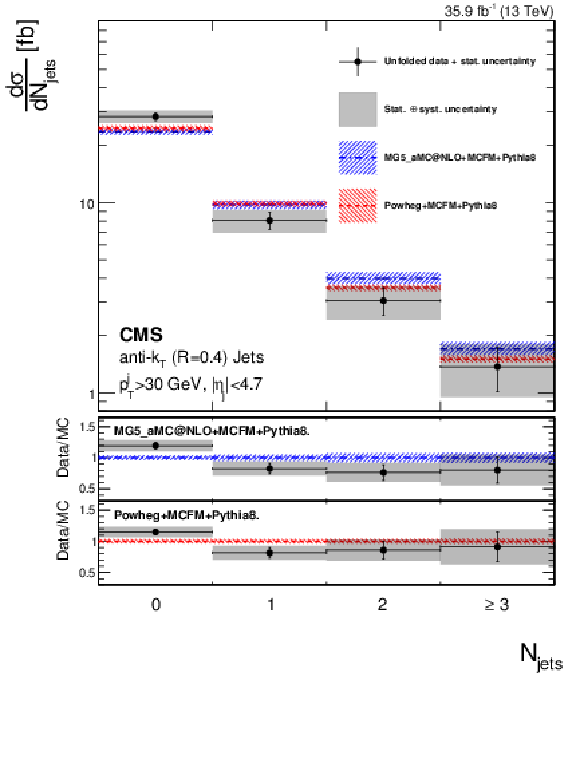
png pdf |
Figure 2-b:
Differential cross sections of $ {\mathrm {p}} {\mathrm {p}}\to {\mathrm {Z}} {\mathrm {Z}} \to 4\ell $ as a function of the multiplicity of jets with $ | \eta _{\mathrm {j}} | < $ 4.7, for the 13 TeV data. The measurements are compared to the predictions of MG5_aMC@nlo, POWHEG, and MadGraph5 (8 TeV only) sets of samples. Each MC set, along with the main MC generator, includes the MCFM and Phantom generators. PYTHIA 6 and PYTHIA 8 are used for parton showering, hadronization, and underlying event simulation, for the 8 and 13 TeV analysis, respectively, with the sole exception of MG5_aMC@nlo, which is always interfaced to PYTHIA 8. The total experimental uncertainties are shown as hatched regions, while the colored bands display the theoretical uncertainties in the matrix element calculations. |
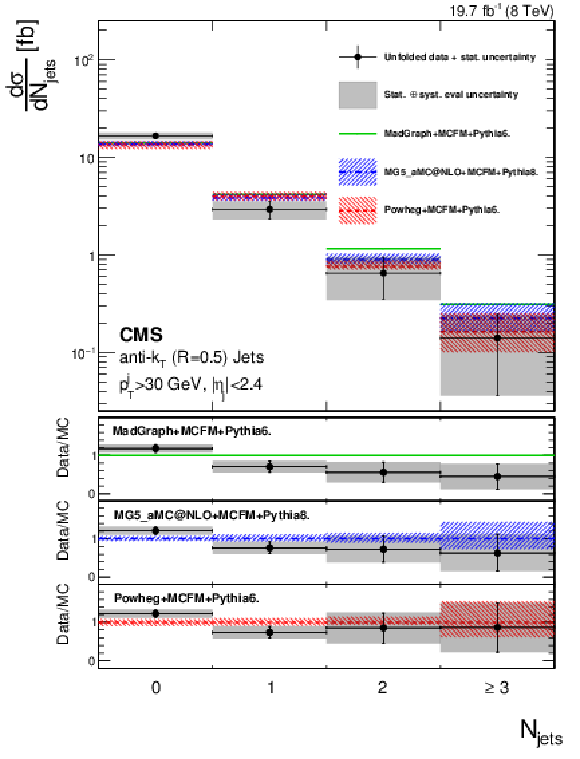
png pdf |
Figure 2-c:
Differential cross sections of $ {\mathrm {p}} {\mathrm {p}}\to {\mathrm {Z}} {\mathrm {Z}} \to 4\ell $ as a function of the multiplicity of jets with $ | \eta _{\mathrm {j}} | < $ 2.4, for the 8 TeV data. The measurements are compared to the predictions of MG5_aMC@nlo, POWHEG, and MadGraph5 (8 TeV only) sets of samples. Each MC set, along with the main MC generator, includes the MCFM and Phantom generators. PYTHIA 6 and PYTHIA 8 are used for parton showering, hadronization, and underlying event simulation, for the 8 and 13 TeV analysis, respectively, with the sole exception of MG5_aMC@nlo, which is always interfaced to PYTHIA 8. The total experimental uncertainties are shown as hatched regions, while the colored bands display the theoretical uncertainties in the matrix element calculations. |
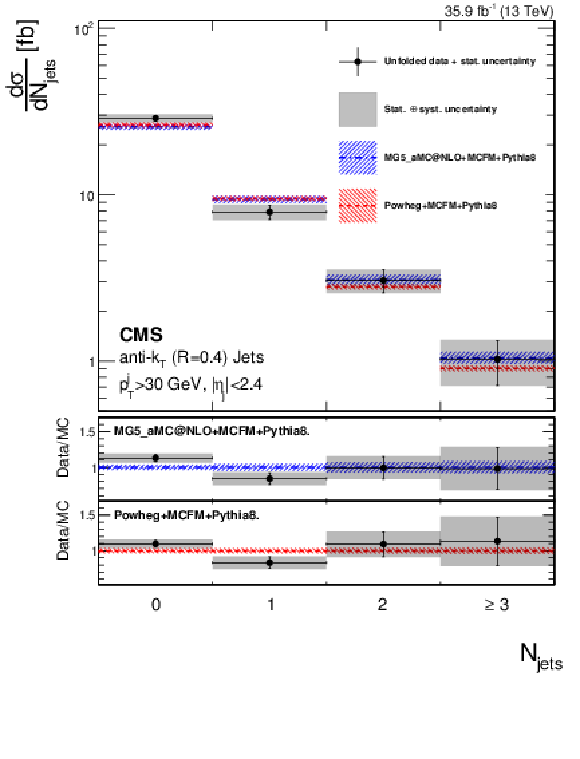
png pdf |
Figure 2-d:
Differential cross sections of $ {\mathrm {p}} {\mathrm {p}}\to {\mathrm {Z}} {\mathrm {Z}} \to 4\ell $ as a function of the multiplicity of jets with $ | \eta _{\mathrm {j}} | < $ 2.4, for the 13 TeV data. The measurements are compared to the predictions of MG5_aMC@nlo, POWHEG, and MadGraph5 (8 TeV only) sets of samples. Each MC set, along with the main MC generator, includes the MCFM and Phantom generators. PYTHIA 6 and PYTHIA 8 are used for parton showering, hadronization, and underlying event simulation, for the 8 and 13 TeV analysis, respectively, with the sole exception of MG5_aMC@nlo, which is always interfaced to PYTHIA 8. The total experimental uncertainties are shown as hatched regions, while the colored bands display the theoretical uncertainties in the matrix element calculations. |
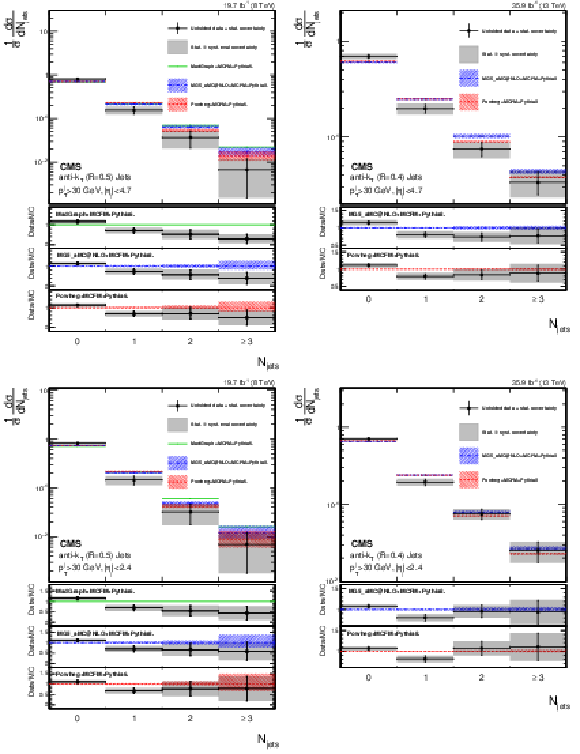
png pdf |
Figure 3:
Differential cross sections normalized to the cross section of $ {\mathrm {p}} {\mathrm {p}}\to {\mathrm {Z}} {\mathrm {Z}} \to 4\ell $ as a function of the multiplicity of jets with $ | \eta _{\mathrm {j}} | < $ 4.7 (top panels) and $ | \eta _{\mathrm {j}} | < $ 2.4 (bottom panels), for the 8 (left) and 13 (right) TeV data. Other details are as described in the caption of Fig. 2. |
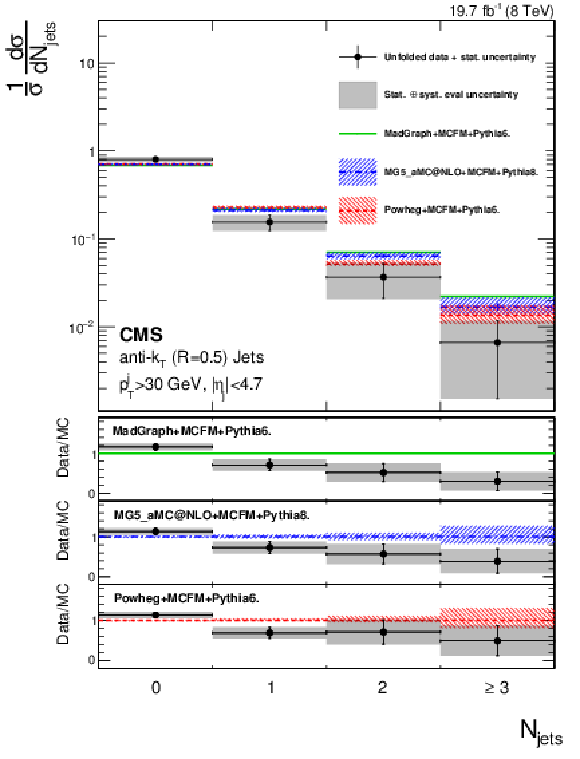
png pdf |
Figure 3-a:
Differential cross sections normalized to the cross section of $ {\mathrm {p}} {\mathrm {p}}\to {\mathrm {Z}} {\mathrm {Z}} \to 4\ell $ as a function of the multiplicity of jets with $ | \eta _{\mathrm {j}} | < $ 4.7, for the 8 TeV data. Other details are as described in the caption of Fig. 2. |
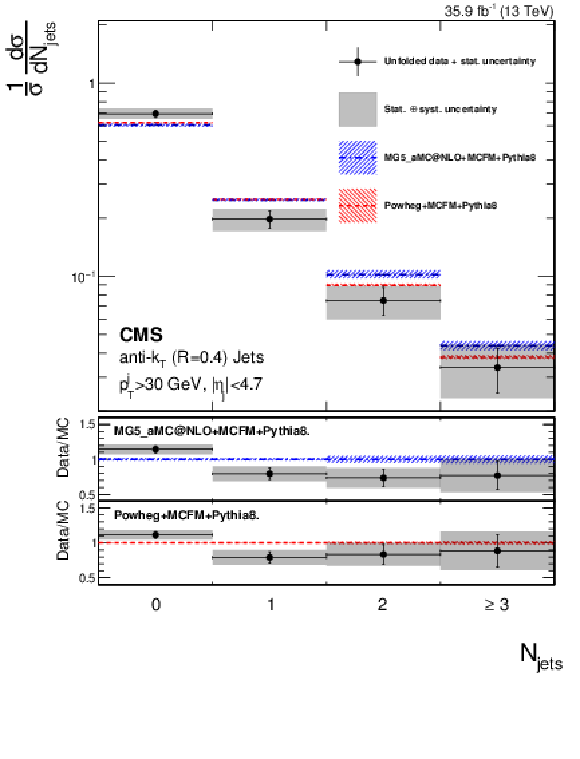
png pdf |
Figure 3-b:
Differential cross sections normalized to the cross section of $ {\mathrm {p}} {\mathrm {p}}\to {\mathrm {Z}} {\mathrm {Z}} \to 4\ell $ as a function of the multiplicity of jets with $ | \eta _{\mathrm {j}} | < $ 4.7, for the 13 TeV data. Other details are as described in the caption of Fig. 2. |
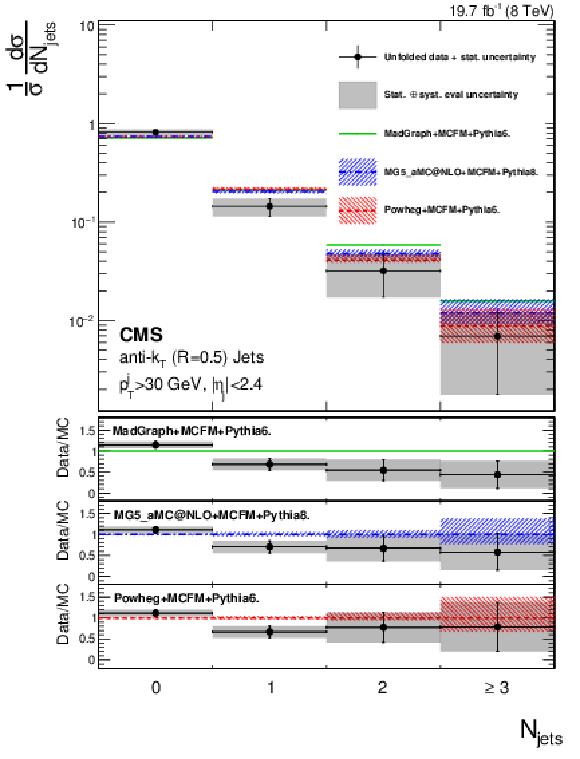
png pdf |
Figure 3-c:
Differential cross sections normalized to the cross section of $ {\mathrm {p}} {\mathrm {p}}\to {\mathrm {Z}} {\mathrm {Z}} \to 4\ell $ as a function of the multiplicity of jets with $ | \eta _{\mathrm {j}} | < $ 2.4, for the 8 TeV data. Other details are as described in the caption of Fig. 2. |
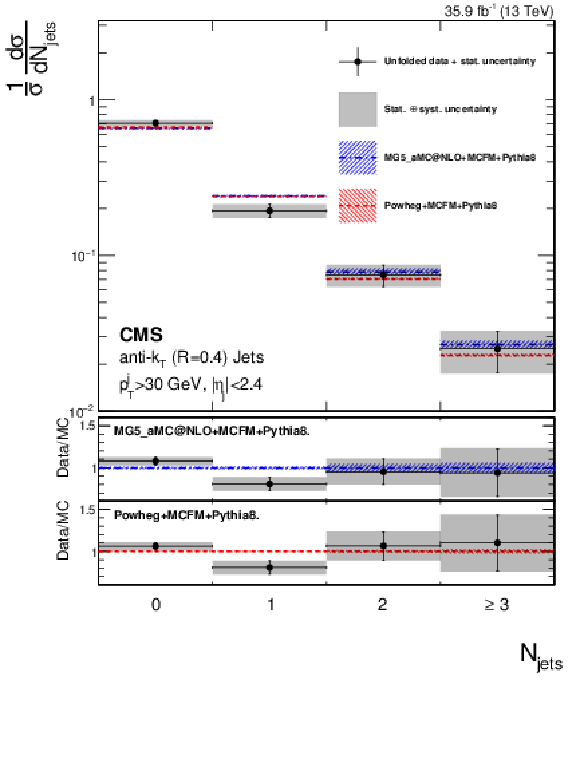
png pdf |
Figure 3-d:
Differential cross sections normalized to the cross section of $ {\mathrm {p}} {\mathrm {p}}\to {\mathrm {Z}} {\mathrm {Z}} \to 4\ell $ as a function of the multiplicity of jets with $ | \eta _{\mathrm {j}} | < $ 2.4, for the 13 TeV data. Other details are as described in the caption of Fig. 2. |
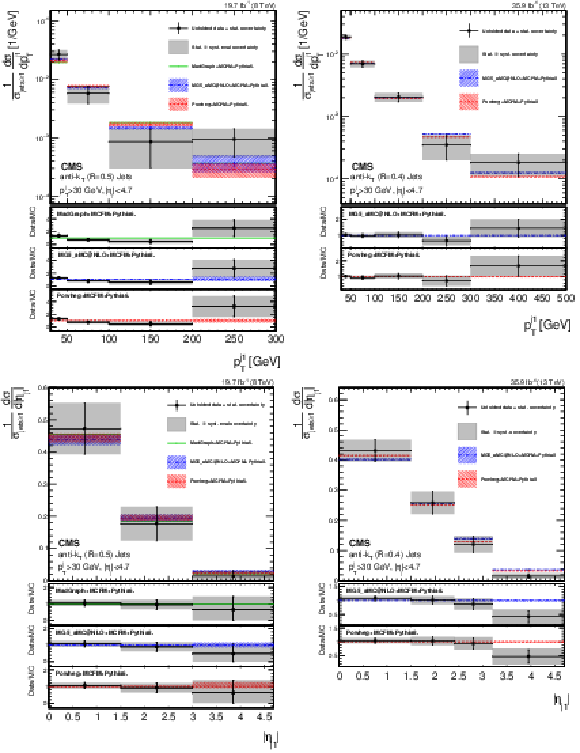
png pdf |
Figure 4:
Differential cross sections normalized to the cross section for $ {N_{\text {jets}}} \ge $ 1 of $ {\mathrm {p}} {\mathrm {p}}\to {\mathrm {Z}} {\mathrm {Z}} \to 4\ell $ as a function of the $ {p_{\mathrm {T}}} $-leading jet transverse momentum (top panels) and the absolute value of the pseudorapidity (bottom panels), for the 8 (left) and 13 (right) TeV data. Other details are as described in the caption of Fig. 2. |
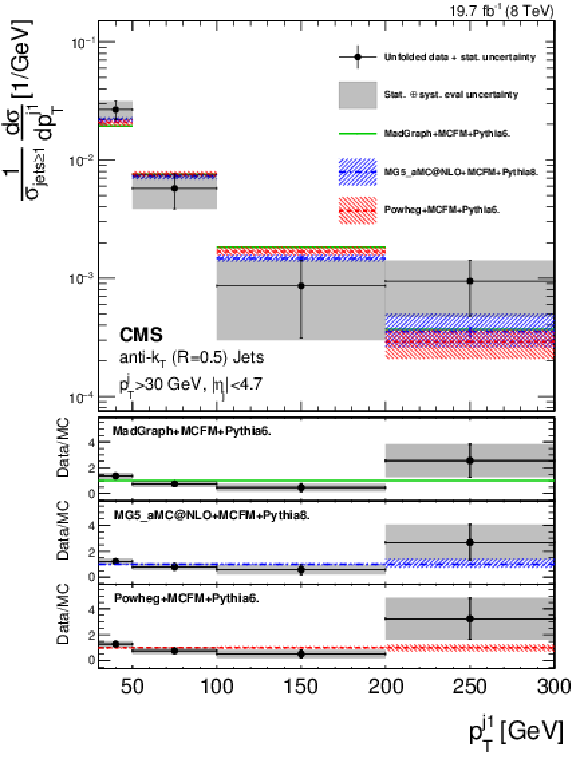
png pdf |
Figure 4-a:
Differential cross sections normalized to the cross section for $ {N_{\text {jets}}} \ge $ 1 of $ {\mathrm {p}} {\mathrm {p}}\to {\mathrm {Z}} {\mathrm {Z}} \to 4\ell $ as a function of the $ {p_{\mathrm {T}}} $-leading jet transverse momentum, for the 8 TeV data. Other details are as described in the caption of Fig. 2. |

png pdf |
Figure 4-b:
Differential cross sections normalized to the cross section for $ {N_{\text {jets}}} \ge $ 1 of $ {\mathrm {p}} {\mathrm {p}}\to {\mathrm {Z}} {\mathrm {Z}} \to 4\ell $ as a function of the $ {p_{\mathrm {T}}} $-leading jet transverse momentum, for the 13 TeV data. Other details are as described in the caption of Fig. 2. |
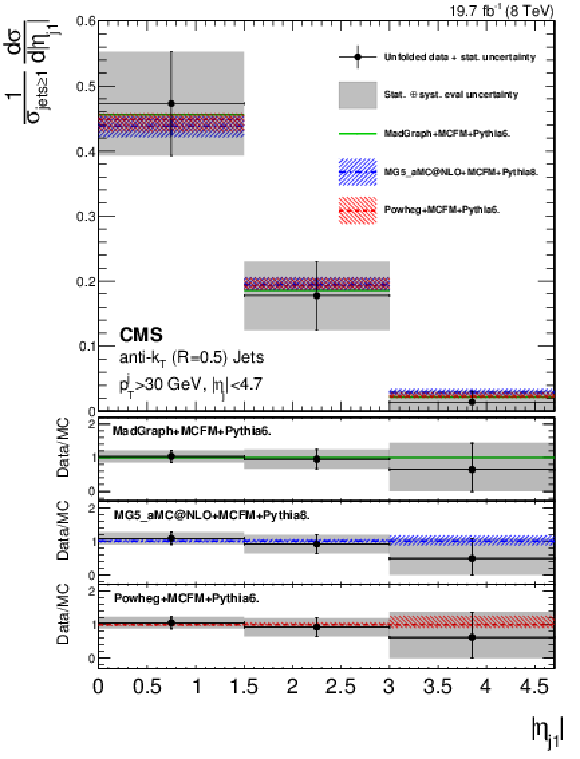
png pdf |
Figure 4-c:
Differential cross sections normalized to the cross section for $ {N_{\text {jets}}} \ge $ 1 of $ {\mathrm {p}} {\mathrm {p}}\to {\mathrm {Z}} {\mathrm {Z}} \to 4\ell $ as a function of the absolute value of the pseudorapidity, for the 8 TeV data. Other details are as described in the caption of Fig. 2. |
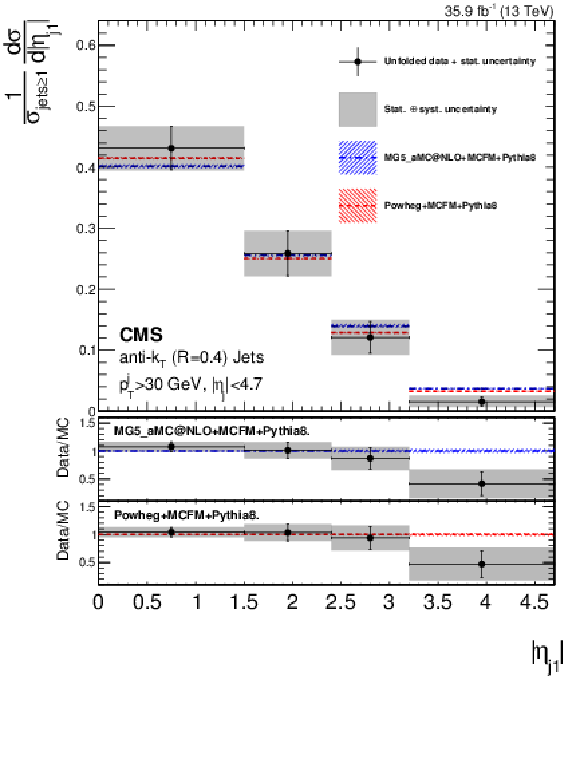
png pdf |
Figure 4-d:
Differential cross sections normalized to the cross section for $ {N_{\text {jets}}} \ge $ 1 of $ {\mathrm {p}} {\mathrm {p}}\to {\mathrm {Z}} {\mathrm {Z}} \to 4\ell $ as a function of the absolute value of the pseudorapidity, for the 13 TeV data. Other details are as described in the caption of Fig. 2. |
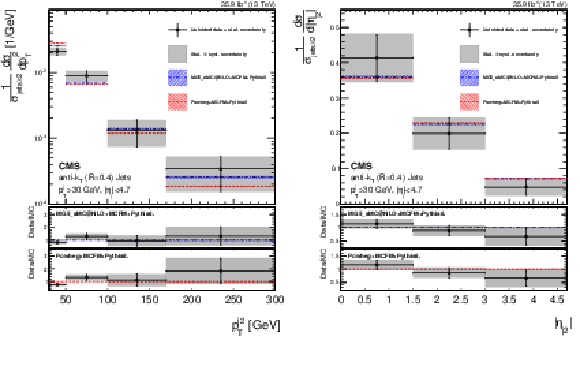
png pdf |
Figure 5:
Differential cross sections normalized to the cross section for $ {N_{\text {jets}}} \ge $ 2 of $ {\mathrm {p}} {\mathrm {p}}\to {\mathrm {Z}} {\mathrm {Z}} \to 4\ell $ at $\sqrt {s} = $ 13 TeV as a function of the $ {p_{\mathrm {T}}} $-subleading jet transverse momentum (left) and the absolute value of the pseudorapidity (right). Other details are as described in the caption of Fig. 2. |
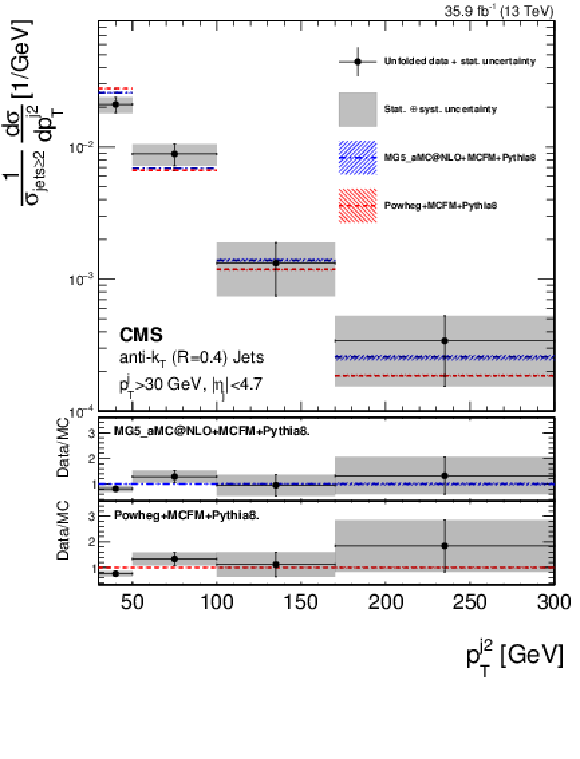
png pdf |
Figure 5-a:
Differential cross sections normalized to the cross section for $ {N_{\text {jets}}} \ge $ 2 of $ {\mathrm {p}} {\mathrm {p}}\to {\mathrm {Z}} {\mathrm {Z}} \to 4\ell $ at $\sqrt {s} = $ 13 TeV as a function of the $ {p_{\mathrm {T}}} $-subleading jet transverse momentum. Other details are as described in the caption of Fig. 2. |
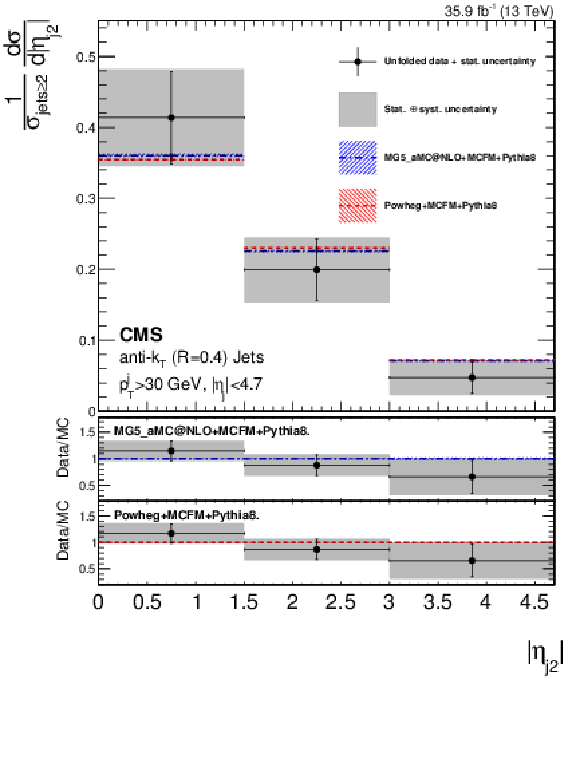
png pdf |
Figure 5-b:
Differential cross sections normalized to the cross section for $ {N_{\text {jets}}} \ge $ 2 of $ {\mathrm {p}} {\mathrm {p}}\to {\mathrm {Z}} {\mathrm {Z}} \to 4\ell $ at $\sqrt {s} = $ 13 TeV as a function of the absolute value of the pseudorapidity. Other details are as described in the caption of Fig. 2. |

png pdf |
Figure 6:
Differential cross sections normalized to the cross section for $ {N_{\text {jets}}} \ge $ 2 of $ {\mathrm {p}} {\mathrm {p}}\to {\mathrm {Z}} {\mathrm {Z}} \to 4\ell $ at $\sqrt {s} = $ 13 TeV as a function of the invariant mass of the two $ {p_{\mathrm {T}}} $-leading jets (left) and their pseudorapidity separation (right). Other details are as described in the caption of Fig. 2. |
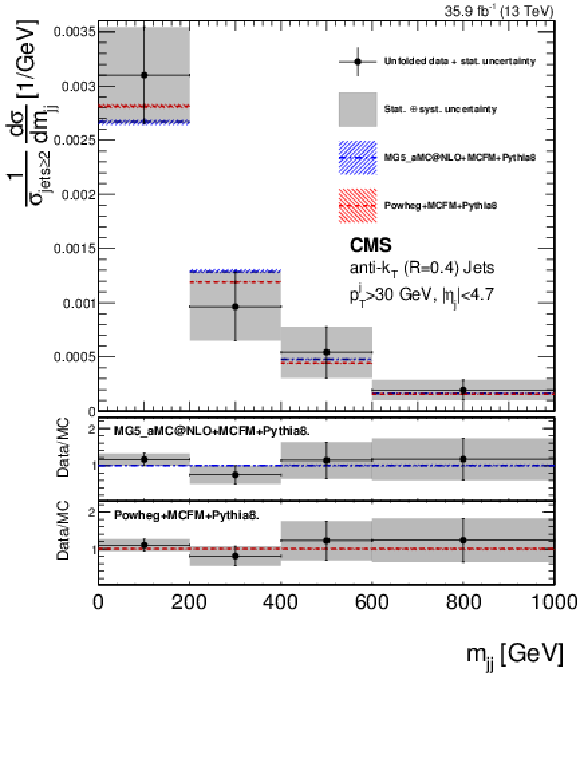
png pdf |
Figure 6-a:
Differential cross sections normalized to the cross section for $ {N_{\text {jets}}} \ge $ 2 of $ {\mathrm {p}} {\mathrm {p}}\to {\mathrm {Z}} {\mathrm {Z}} \to 4\ell $ at $\sqrt {s} = $ 13 TeV as a function of the invariant mass of the two $ {p_{\mathrm {T}}} $-leading jets. Other details are as described in the caption of Fig. 2. |
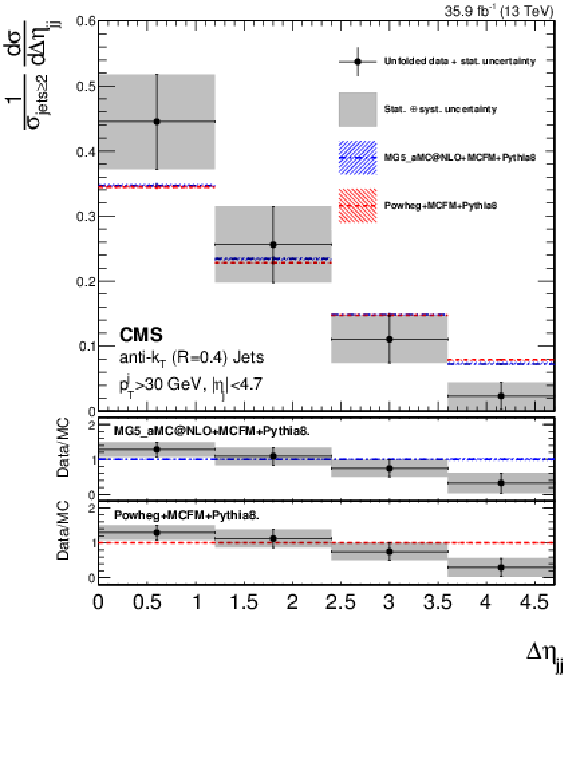
png pdf |
Figure 6-b:
Differential cross sections normalized to the cross section for $ {N_{\text {jets}}} \ge $ 2 of $ {\mathrm {p}} {\mathrm {p}}\to {\mathrm {Z}} {\mathrm {Z}} \to 4\ell $ at $\sqrt {s} = $ 13 TeV as a function of the pseudorapidity separation of the two $ {p_{\mathrm {T}}} $-leading jets. Other details are as described in the caption of Fig. 2. |
| Tables | |
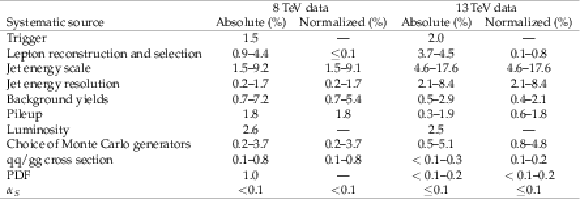
png pdf |
Table 1:
The contributions to the uncertainty in the absolute and normalized differential cross section measurements. Uncertainties that depend on jet multiplicity are listed as ranges. |
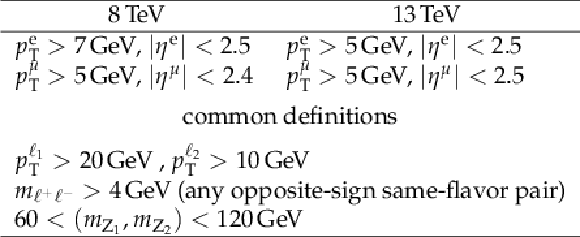
png pdf |
Table 2:
Phase space definitions for cross section measurements at 8 TeV [6] and 13 TeV [8]. The common definitions apply to both measurements. |

png pdf |
Table 3:
The $ {\mathrm {p}} {\mathrm {p}}\to {\mathrm {Z}} {\mathrm {Z}} \to \ell \ell \ell '\ell '$ cross section at $\sqrt {s} = $ 8 TeV as a function of the jet multiplicity. The integrated luminosity uncertainty for number of jets = 2 and $\ge $3 is negligible and not quoted. The cross sections are compared to the theoretical predictions (last column) from MG5_aMC@nlo+MCFM+Phantom. |

png pdf |
Table 4:
The $ {\mathrm {p}} {\mathrm {p}}\to {\mathrm {Z}} {\mathrm {Z}} \to \ell \ell \ell '\ell '$ cross section at $\sqrt {s} = $ 13 TeV as a function of the jet multiplicity. The integrated luminosity uncertainty for the number of jets $\ge $3 is smaller than 0.1 fb and is not quoted. The cross sections are compared to the theoretical predictions (last column) from MG5_aMC@nlo+MCFM+Phantom. |
| Summary |
| The differential cross sections for the production of Z pairs in the four-lepton final state in association with jets in proton-proton collisions at $\sqrt{s}=$ 8 and 13 TeV have been measured. The data correspond to an integrated luminosity of 19.7 (35.9) fb$^{-1}$ for a center-of-mass energy of 8 (13) TeV. Cross sections are presented for the production of a pair of Z bosons as a function of the number of jets, the transverse momentum $ {p_{\mathrm{T}}} $, and pseudorapidity of the $ {p_{\mathrm{T}}} $-leading and subleading jets. Distributions of the invariant mass of the two $ {p_{\mathrm{T}}} $-leading jets and their separation in pseudorapidity are also presented. Good agreement is observed between the measurements and the theoretical predictions when next-to-leading order matrix-element calculations are used together with the PYTHIA parton shower simulation. Cross sections for ZZ production in association with jet have been measured with a precision ranging from 10 to 72% (8 to 38%) at 8 (13) TeV, for jet multiplicities ranging from 0 to $\geq$ 3. The systematic uncertainty is of the same size, or smaller, than the statistical one. Analyses using future, larger data sets, with smaller statistical uncertainties, will allow the theoretical prediction of ZZ+jets to undergo more stringent tests. |
| References | ||||
| 1 | M. Lemoine and M. J. G. Veltman | Radiative corrections to $ \mathrm{e}^{+} \mathrm{e}^{-} \to \mathrm{W}^{+} \mathrm{W}^{-} $ in the Weinberg model | NPB 164 (1980) 445 | |
| 2 | ATLAS Collaboration | Measurement of $ \mathrm{Z}\mathrm{Z} $ production in $ {\mathrm{p}}{\mathrm{p}} $ collisions at $ \sqrt{s}= $ 7 TeV and limits on anomalous $ \mathrm{Z}\mathrm{Z}\mathrm{Z} $ and $ \mathrm{Z}\mathrm{Z}\gamma $ couplings with the ATLAS detector | JHEP 03 (2013) 128 | 1211.6096 |
| 3 | ATLAS Collaboration | Measurement of the $ \mathrm{Z}\mathrm{Z} $ production cross section in pp collisions at $ \sqrt{s} = $ 13 TeV with the ATLAS detector | PRL 116 (2016) 101801 | 1512.05314 |
| 4 | ATLAS Collaboration | $ \mathrm{Z}\mathrm{Z} \to \ell^{+}\ell^{-}\ell^{\prime +}\ell^{\prime -} $ cross-section measurements and search for anomalous triple gauge couplings in 13 $ TeV {\mathrm{p}}{\mathrm{p}} $ collisions with the ATLAS detector | PRD 97 (2018) 032005 | 1709.07703 |
| 5 | CMS Collaboration | Measurement of the $ \mathrm{Z}\mathrm{Z} $ production cross section and search for anomalous couplings in $ 2\ell2\ell' $ final states in $ {\mathrm{p}}{\mathrm{p}} $ collisions at $ \sqrt{s}= $ 7 TeV | JHEP 01 (2013) 063 | CMS-SMP-12-007 1211.4890 |
| 6 | CMS Collaboration | Measurement of the $ {\mathrm{p}}{\mathrm{p}} \to \mathrm{Z}\mathrm{Z} $ production cross section and constraints on anomalous triple gauge couplings in four-lepton final states at $ \sqrt{s}= $ 8 TeV | PLB 740 (2015) 250 | CMS-SMP-13-005 1406.0113 |
| 7 | CMS Collaboration | Measurement of the $ \mathrm{Z}\mathrm{Z} $ production cross section and Z $ \to \ell^+\ell^-\ell'^+\ell'^- $ branching fraction in pp collisions at $ \sqrt{s} = $ 13 TeV | PLB 763 (2016) 280 | CMS-SMP-16-001 1607.08834 |
| 8 | CMS Collaboration | Measurements of the $ \mathrm {p}\mathrm {p}\rightarrow \mathrm{Z}\mathrm{Z} $ production cross section and the $ \mathrm{Z}\rightarrow 4\ell $ branching fraction, and constraints on anomalous triple gauge couplings at $ \sqrt{s} = $ 13 TeV | EPJC 78 (2018) 165 | CMS-SMP-16-017 1709.08601 |
| 9 | CMS Collaboration | Measurement of vector boson scattering and constraints on anomalous quartic couplings from events with four leptons and two jets in proton-proton collisions at $ \sqrt{s} = $ 13 TeV | PLB 774 (2017) 682 | CMS-SMP-17-006 1708.02812 |
| 10 | CMS Collaboration | Description and performance of track and primary-vertex reconstruction with the CMS tracker | JINST 9 (2014) P10009 | CMS-TRK-11-001 1405.6569 |
| 11 | CMS Collaboration | The CMS trigger system | JINST 12 (2017) P01020 | CMS-TRG-12-001 1609.02366 |
| 12 | CMS Collaboration | The CMS experiment at the CERN LHC | JINST 3 (2008) S08004 | CMS-00-001 |
| 13 | J. Alwall et al. | Comparative study of various algorithms for the merging of parton showers and matrix elements in hadronic collisions | EPJC 53 (2008) 473 | 0706.2569 |
| 14 | J. Alwall et al. | The automated computation of tree-level and next-to-leading order differential cross sections, and their matching to parton shower simulations | JHEP 07 (2014) 079 | 1405.0301 |
| 15 | T. Melia, P. Nason, R. Rontsch, and G. Zanderighi | $ \mathrm{W}^+\mathrm{W}^- $ , $ \mathrm{W}\mathrm{Z} $ and $ \mathrm{Z}\mathrm{Z} $ production in the POWHEG BOX | JHEP 11 (2011) 078 | 1107.5051 |
| 16 | P. Nason | A new method for combining NLO QCD with shower Monte Carlo algorithms | JHEP 11 (2004) 040 | hep-ph/0409146 |
| 17 | S. Frixione, P. Nason, and C. Oleari | Matching NLO QCD computations with parton shower simulations: the POWHEG method | JHEP 11 (2007) 070 | 0709.2092 |
| 18 | S. Alioli, P. Nason, C. Oleari, and E. Re | A general framework for implementing NLO calculations in shower Monte Carlo programs: the POWHEG BOX | JHEP 06 (2010) 043 | 1002.2581 |
| 19 | R. Frederix and S. Frixione | Merging meets matching in MC@NLO | JHEP 12 (2012) 061 | 1209.6215 |
| 20 | F. Cascioli et al. | $ \mathrm{Z}\mathrm{Z} $ production at hadron colliders in NNLO QCD | PLB 735 (2014) 311 | 1405.2219 |
| 21 | J. M. Campbell and R. K. Ellis | MCFM for the Tevatron and the LHC | NPB Proc. Suppl. 10 (2010) 205 | 1007.3492 |
| 22 | F. Caola, K. Melnikov, R. Rontsch, and L. Tancredi | QCD corrections to $ \mathrm{Z}\mathrm{Z} $ production in gluon fusion at the LHC | PRD 92 (2015) 094028 | 1509.06734 |
| 23 | A. Ballestrero et al. | PHANTOM: A Monte Carlo event generator for six parton final states at high energy colliders | CPC 180 (2009) 401 | 0801.3359 |
| 24 | T. Sjostrand, S. Mrenna, and P. Skands | PYTHIA 6.4 physics and manual | JHEP 05 (2006) 026 | hep-ph/0603175 |
| 25 | CMS Collaboration | Study of the underlying event at forward rapidity in pp collisions at $ \sqrt{s} = $ 0.9, 2.76, and 7 TeV | JHEP 04 (2013) 072 | CMS-FWD-11-003 1302.2394 |
| 26 | T. Sjostrand et al. | An introduction to PYTHIA 8.2 | CPC 191 (2015) 159 | 1410.3012 |
| 27 | H.-L. Lai et al. | Uncertainty induced by QCD coupling in the CTEQ global analysis of parton distributions | PRD 82 (2010) 054021 | 1004.4624 |
| 28 | H.-L. Lai et al. | New parton distributions for collider physics | PRD 82 (2010) 074024 | 1007.2241 |
| 29 | CMS Collaboration | Event generator tunes obtained from underlying event and multiparton scattering measurements | EPJC 76 (2016) 155 | CMS-GEN-14-001 1512.00815 |
| 30 | NNPDF Collaboration | Parton distributions for the LHC run II | JHEP 04 (2015) 040 | 1410.8849 |
| 31 | GEANT4 Collaboration | $ GEANT4 $ --- a simulation toolkit | NIMA 506 (2003) 250 | |
| 32 | CMS Collaboration | Particle-flow reconstruction and global event description with the CMS detector | JINST 12 (2017) P10003 | CMS-PRF-14-001 1706.04965 |
| 33 | M. Cacciari, G. P. Salam, and G. Soyez | The anti-$ \mathrm{k}_\mathrm{t} $ jet clustering algorithm | JHEP 04 (2008) 063 | 0802.1189 |
| 34 | M. Cacciari, G. P. Salam, and G. Soyez | FastJet user manual | EPJC 72 (2012) 1896 | 1111.6097 |
| 35 | CMS Collaboration | Performance of electron reconstruction and selection with the CMS detector in proton-proton collisions at $ \sqrt{s} = $ 8 TeV | JINST 10 (2015) P06005 | CMS-EGM-13-001 1502.02701 |
| 36 | CMS Collaboration | Performance of CMS muon reconstruction in $ {\mathrm{p}}{\mathrm{p}} $ collision events at $ \sqrt{s} = $ 7 TeV | JINST 7 (2012) P10002 | CMS-MUO-10-004 1206.4071 |
| 37 | M. Cacciari and G. P. Salam | Pileup subtraction using jet areas | PLB 659 (2008) 119 | 0707.1378 |
| 38 | The ALEPH Collaboration, the DELPHI Collaboration, the L3 Collaboration, the OPAL Collaboration, the SLD Collaboration, the LEP Electoweak Working Group, the SLD Electroweak and Heavy Flavour Groups | Precision electroweak measurements on the Z resonance | Phys. Rep. 427 (2006) 257 | |
| 39 | CMS Collaboration | Measurement of the properties of a Higgs boson in the four-lepton final state | PRD 89 (2014) 092007 | CMS-HIG-13-002 1312.5353 |
| 40 | CMS Collaboration | Measurements of properties of the Higgs boson decaying into the four-lepton final state in $ {\mathrm{p}}{\mathrm{p}} $ collisions at $ \sqrt{s} = $ 13 TeV | JHEP 11 (2017) 047 | CMS-HIG-16-041 1706.09936 |
| 41 | CMS Collaboration | Measurement of the inclusive $ \mathrm{W} $ and $ \mathrm{Z} $ production cross sections in $ {\mathrm{p}}{\mathrm{p}} $ collisions at $ \sqrt{s} = $ 7 TeV | JHEP 10 (2011) 132 | CMS-EWK-10-005 1107.4789 |
| 42 | CMS Collaboration | Jet energy scale and resolution performances with 13 TeV data | CDS | |
| 43 | CMS Collaboration | Jet energy scale and resolution in the CMS experiment in $ {\mathrm{p}}{\mathrm{p}} $ collisions at 8 TeV | JINST 12 (2017) P02014 | CMS-JME-13-004 1607.03663 |
| 44 | CMS Collaboration | Jet algorithms performance in 13 TeV data | CMS-PAS-JME-16-003 | CMS-PAS-JME-16-003 |
| 45 | CMS Collaboration | CMS luminosity based on pixel cluster counting --- summer 2013 update | CMS-PAS-LUM-13-001 | CMS-PAS-LUM-13-001 |
| 46 | CMS Collaboration | CMS luminosity measurements for the 2016 data taking period | CMS-PAS-LUM-17-001 | CMS-PAS-LUM-17-001 |
| 47 | M. Botje et al. | The PDF4LHC working group interim recommendations | 1101.0538 | |
| 48 | S. Alekhin et al. | The PDF4LHC working wroup interim report | 1101.0536 | |
| 49 | J. Butterworth et al. | PDF4LHC recommendations for LHC Run II | JPG 43 (2016) 023001 | 1510.03865 |
| 50 | NNPDF Collaboration | Impact of heavy quark masses on parton distributions and LHC phenomenology | NPB 849 (2011) 296 | 1101.1300 |
| 51 | G. D'Agostini | A multidimensional unfolding method based on Bayes' theorem | NIMA 362 (1995) 487 | |
| 52 | T. Adye | Unfolding algorithms and tests using RooUnfold | Proceedings, PHYSTAT 2011 Workshop on Statistical Issues Related to Discovery Claims in Search Experiments and Unfolding, CERN,Geneva, Switzerland 17-20 January 2011 (2011) 313 | 1105.1160 |
| 53 | A. Hocker and V. Kartvelishvili | SVD approach to data unfolding | NIMA 372 (1996) 469 | hep-ph/9509307 |

|
Compact Muon Solenoid LHC, CERN |

|

|

|

|

|

|